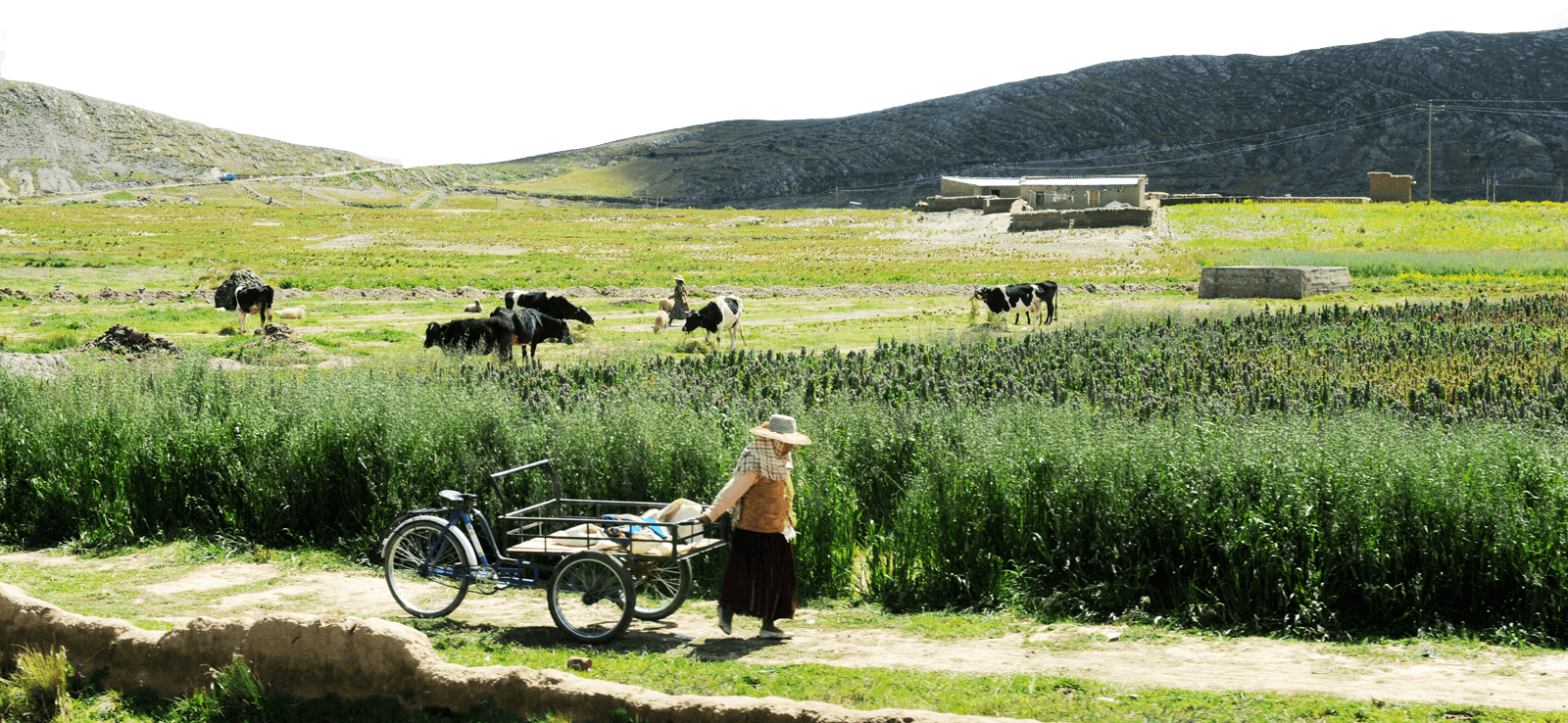Agroecology “Lite:” Cooptation and Resistance in the Global North
The Green Revolution is a one-size-fits-all technological model for global agricultural development that originated in the breadbasket of the United States. Following World War II, the US turned “swords into plowshares” by transforming the vast stocks of wartime nitrate and poisons into fertilizer and pesticides, and by refitting arms factories to make newer, bigger farm machinery. Hybrid seeds were bred to respond to irrigation and chemical inputs. Industrial agriculture boomed.
However, US farmers soon bought all of the new technology they needed. Seeds, agrochemicals and machinery began to pile up in warehouses. The solution to the problem of industrial surplus was to export the uniform model of production to very different and diverse geographical, cultural and social environments in the Global South.
“A good aggressive bunch of American agronomists and plant breeders could ruin native resources for good and all by pushing their American stocks.” [i]
Carl Sauer, a highly respected Professor of Geography at the University of California, Berkeley with vast experience in Latin American agriculture, was originally contracted by the Rockefeller Foundation as a consultant to the US Mexican Agricultural Program regarding the possibility of exporting US agricultural technology to Mexico—ostensibly to help Mexico increase their food security. But Sauer strongly advised Rockefeller against the approach:
“A good aggressive bunch of American agronomists and plant breeders could ruin native resources for good and all by pushing their American stocks…and Mexico cannot be pointed toward standardization on a few commercial types without upsetting native economy and culture hopelessly. Unless the Americans understand that, they better keep out of this country entirely. This must be approached from an appreciation of native economies as basically sound.” [i]
The Rockefeller Foundation dismissed Sauer’s concerns and, despite internal opposition, went forward with the project—which became a 50-year global campaign—later known as the Green Revolution.
The Green Revolution was spread with subsidized credit, international institutions and government programs, to millions of farmers in the Global South. With massive investment, global food production increased dramatically. But, Carl Sauer’s predictions came true: because the technology required capital, it concentrated production on large farms and in fewer and fewer hands—the best agricultural land. Smallholders were driven to the fragile hillsides and into the rain forests. When they were offered cheap credit to buy Green Revolution seeds and chemicals, these inputs quickly destroyed the fertility of their soils and eroded their local genetic diversity. Yields fell, millions of small farmers were economically ruined, and millions of acres of forests and topsoil were lost.
Stay in the loop with Food First!
Get our independent analysis, research, and other publications you care about to your inbox for free!
Sign up today!The Green Revolution proved to be a disastrous mismatch for the Global South. In its aftermath, peasant farmers struggled to stay on the land and restore the ecological integrity of their farming systems. They found a way with Agroecology.
Although many northern academics claim that the term Agroecology was first coined by European scientists at the beginning of the 20th century,[ii] the roots of agroecology lie in the ecological rationale of indigenous and peasant agriculture still prevalent in many parts of the developing world today.[iii]
Thirty years ago, Latin American agroecologists argued that a starting point for a better, pro-poor agricultural development strategies were the systems that traditional farmers had developed over centuries. From the early1980s on, hundreds of agroecologically-based projects incorporating elements of both traditional knowledge and modern agricultural science have been promoted throughout Latin America and other parts of the developing world. A variety of projects emerged showing that over time these agroecologically-managed systems bring benefits to rural communities by enhancing food security with healthy local food, strengthening their resource base (soils, biodiversity, etc.), preserving cultural heritage and the peasant or family farm way of life, and promoting resilience to climate change.[iv]
Because they are often developed and shared through extensive Campesino a Campesino (farmer-to-farmer) social networks, peasant-based agroecological approaches are an integral part of many agrarian struggles for land and market reforms… For them, agroecology is… a science, a practice and a movement.
Agroecology also contributes towards the process of “re-peasantization” in which, contrary to the general tendency of migration from the countryside to the city, smallholders are returning to the land. For peasant organizations, agroecology has proven vital in their struggle for autonomy by reducing their dependence on external inputs, credit and indebtedness and also by recovering their territories.[v] Because they are often developed and shared through extensive Campesino a Campesino (farmer-to-farmer) social networks, peasant-based agroecological approaches are an integral part of many agrarian struggles for land and market reforms as well as peasant movements against land grabs and extractive industries. For them, agroecology is not just a scientific or technological project, but a political project of resistance and survival. It is a science, a practice and a movement.
Agroecology is spreading in the US and Europe. This is good news. But similar to the southward spread of the Green Revolution, the northward spread of agroecology has encountered a mismatch, and it is political.
In Latin America, agroecology is often viewed as an applied science embedded within a social context that challenges capitalist agriculture and is allied with agrarian movements. Deeply engaged with ongoing agrarian debates, Latin American agroecologists typically support both bottom-up agricultural development and peasant resistance against the corporate, industrial agriculture and neoliberal trade policies.
Agroecology is spreading in the US and Europe. This is good news. But similar to the southward spread of the Green Revolution, the northward spread of agroecology has encountered a mismatch, and it is political.
The political dimension of agroecology is problematic in the Global North—particularly in the United States—because challenging the root causes of industrial agriculture’s socio-environmental destruction implies challenging capitalism itself.
The political dimension of agroecology is problematic in the Global North—particularly in the United States—because challenging the root causes of industrial agriculture’s socio-environmental destruction implies challenging capitalism itself. It requires a radical (i.e. going to the root) critique that transcends the notion that minor adjustments or ‘greening’ the neoliberal economic model will bring about substantive change. It situates agroecology outside mainstream academic, government and non-governmental programs and within the resistance struggles of the social movements fighting for food sovereignty, local autonomy, and community control of land, water and agrobiodiversity.[vi]
But, agroecology in the US and Europe is not anchored in strong agrarian movements. The northern arena of agroecological debate is dominated by an eclectic soup of apolitical narratives (read: avoiding the subject of capitalism), largely promoted by consumers and academics, global institutions, big NGOs and big philanthropy. This institutional camp uses a variety of terms (sustainable intensification, climate-smart agriculture, diversified farming systems, etc.) to promote a reformist definition of agroecology as a set of additional tools to improve everyone’s toolbox. Big, small, organic, conventional… will all get along better with a little more agroecology.
Agroecology—as a countermovement to the Green Revolution—is at a crossroads, struggling against cooptation, subordination, and revisionist projects that erase its history and strip it of its political meaning.[vii]
The cooptation of agroecological practices will make industrial agriculture a bit more sustainable and a little less exploitative, but will not challenge underlying relations of power in our food system. Further, agroecology “lite” ignores the ways in which large-scale, industrial monocultures undermine the existence of the smallholder farmers who farm agroecologically. The voices of agroecological practitioners —Afro-American, Latino, Indigenous and Asian communities, smallholders and urban farmers—and of low income consumers, progressive academics and NGOs critical of conventional agriculture, are marginal or muted in this discourse.
Agroecology—as a countermovement to the Green Revolution—is at a crossroads, struggling against cooptation, subordination, and revisionist projects that erase its history and strip it of its political meaning.[vii] De-politicized agroecology is socially meaningless, divorced from agrarian realities, vulnerable to the corporate food regime and isolated from the growing power of global food sovereignty movements.
Whether one recognizes the politics of agroecology—or tries to hide them—it is precisely these agrarian politics that will determine our agricultural future.
Agroecology has a pivotal role to play in the future of our food systems. If it is co-opted by reformist trends in the Green Revolution, the agroecological countermovement will be weakened, the corporate food regime will likely be strengthened, and substantive reforms to our food systems will be highly unlikely. However, if agroecologists build strategic alliances with food sovereignty and agrarian movements—at home and abroad—the countermovement will be strengthened. A strong countermovement could generate considerable political will for the transformation of our food systems.[viii]
Whether one recognizes the politics of agroecology—or tries to hide them—it is precisely these agrarian politics that will determine our agricultural future.
Miguel A. Altieri, University of California, Berkeley
Eric Holt-Giménez, Food First
[i] Jennings, B. (1988) Foundations of International Agricultural Research: Science and Politics in Mexican Agriculture. Boulder CO: Westview Press.
[ii] Wezel, A., S. Bellon, T. Doré, C. Francis, D. Vallod and C. David. (2009) Agroecology as a science, a movement, and a practice. A Review. Agronomy for Sustainable Development, 29(4): 503–515.
[iii] Altieri, M.A. (2002) Agroecology: the science of natural resource management for poor farmers in marginal environments. Agriculture, Ecosystems and Environment. 93: 1–24.
[iv] Altieri, M.A. and C.I. Nicholls. (2008) Scaling up Agroecological Approaches for Food Sovereignty in Latin America. Development, 51(4): 472–80. URL: http://dx.doi.org/10.1057/dev.2008.68
[v] Van der Ploeg, J.D. (2009) The New Peasantries: Struggles for Autonomy and Sustainability in an Era of Empire and Globalization. Earthscan, London, 356 p.
[vi] Rosset, P.M. & Martinez-Torres, M.E. (2012) Rural Social Movements and Agroecology: Context, Theory and Process. Ecology and Society, 17: 17-26
[vii] Roland, P. C, and R. W. Adamchak. (2009) Tomorrow’s Table: Organic Farming, Genetics and the Future of Food. Oxford, UK: Oxford University Press.
Tomich, T., S. Brodt, F. Ferris, R. Galt, W. Horwath, E. Kebreab, J. Leveau, et al. (2011) Agroecology: A Review from a Global-Change Perspective. Annual Review of Environment and Resources 36(15): 1–30.
[viii] Holt-Gimenez, E and M.A. Altieri 2013 Agroecology, Food Sovereignty, and the New Green Revolution. Agroecology and Sustainable Food Systems 37: 90-102


 Help Food First to continue growing an informed, transformative, and flourishing food movement.
Help Food First to continue growing an informed, transformative, and flourishing food movement.




